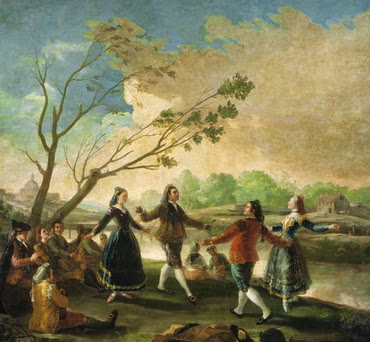Second post of the ten buggy songs series, a guest post by Alicia Cano. She's talking about croackroaches, these... ¿lovely? bugs. Thank you very much, Alicia!

El baile de San Antonio de la Florida - F. de Goya
When Fernando Sor, or Ferran Sors (Barcelona, 1778 – Paris, 1839) first got drawn by the guitar it was no more than a popular instrument, and no serious composers had paid any attention to it. Sor contributed to dignify and introduce it in the concert hall, and that’s why today he is best known as a guitar composer, teacher and player, but his work as a musician is much larger than that and includes operas, ballets and, of course, songs. Like the one in today’s post, one of the “Twelve seguidillas boleras”, composed around 1810.
So what is a seguidilla? To begin with, it’s a poem, a strophic form like the sonnet, coming from folk tradition and covering themes that range from romance to satire. They were often set to music and danced, and as in many popular forms it changed over the years and across regions.
The name “seguidilla” comes from the way it was danced linking one strophe with the next, without refrain or pause: one strophe follows (from the verb “seguir”, to follow) the other. Even when the form evolved it has always kept the original name, often adding an adjective (machega, gitana, bolera…) that highlighted either its origin or local variation.
The structure of the seguidilla is very simple: one strophe (called “copla”) of four verses alternating seven and five syllables with rhyme between second and fourth and fifth and seventh. It can also add another three-verses strophe (“estribillo”) with five, seven and five syllables and rhyme between first and third. Are you lost? Me too.
Maybe it will be easier with an example. Before getting into the one that gives title to this post (and bugs!), this is another seguidilla set to music by Sor:
Verse:
Las mujeres y cuerdas (7 sílabas)
De la guitarra, (5)
Es menester talento (7)
Para templarlas. (5) – rima asonante con “guitarra”
Refrain:
Flojas no suenan (5)
Y suelen saltar muchas (7)
Si las aprietan. (5) – rima asonante con “suenan”
(It roughly translates to: “women and strings/from the guitar/need talent/to be tuned./If loose they won’t sound/and they will break/if too tight).
Yeah, talk about being politically correct.
At the end of XVIII century, when Sor lived, the seguidilla had become a popular dance and almost a matter of national identity against foreign dances. A return to “primitive” art was in fashion across Europe, anticipating Romanticism, and Spanish aristocracy resisting French influence valued Spanish folklore and tradition above all. So the seguidilla bolera turned into aristocratic entertainment from its humble origins as a popular dance to be even executed by professional dancers during play intervals at theaters.
These seguidillas placed further from popular taste were enriched with virtuosic elements from serious music and opera. That’s why we’ll find an abundance of melismas, wide intervals and all kinds of vocal effects in these seguidillas turned into art songs.
Sor contributed to spreading the seguidilla through Europe (he lived since his exile in London and Moscow besides Paris, where he established), where it was quickly appreciated as a token of “exotic Spain”, a stereotype that led to curious, to a Spanish eye, interpretations like Bizet’s Carmen (where a seguidilla is mentioned, by the way).
At this particular moment you may be wondering where crockroaches fit in this story. Well, poor souls are used as scapegoats in song Muchacha, ¿y la vergüenza? (“Girl, where is your modesty?”), a dialog between a not-so-innocent young woman and her mother, telling her off because of her impudent behaviour (like an Eighteen century version of “you’re not going out dressed like that”). We will listen to Anna Alàs I Jové accompanied by guitarrist Eugeni Muriel:
Muchacha, y la vergüenza
- Muchacha, ¿y la vergüenza,
dónde se ha ido?
- Las cucarachas, madre,
se la han comido.
- Muchacha, mientes,
porque las cucarachas
no tienen dientes.
- Girl, and your modesty?
Where did it go?
- Crockroaches, mother
ate it all.
- Girl, you’re lying
because crockroaches
are toothless.
I’m not sure this lovely song will make you see crockroaches in a different light, but I do hope you enjoy Sor’s art and that, if you didn’t know about it, it has been a happy finding, like it was for me when I first listened to it.












